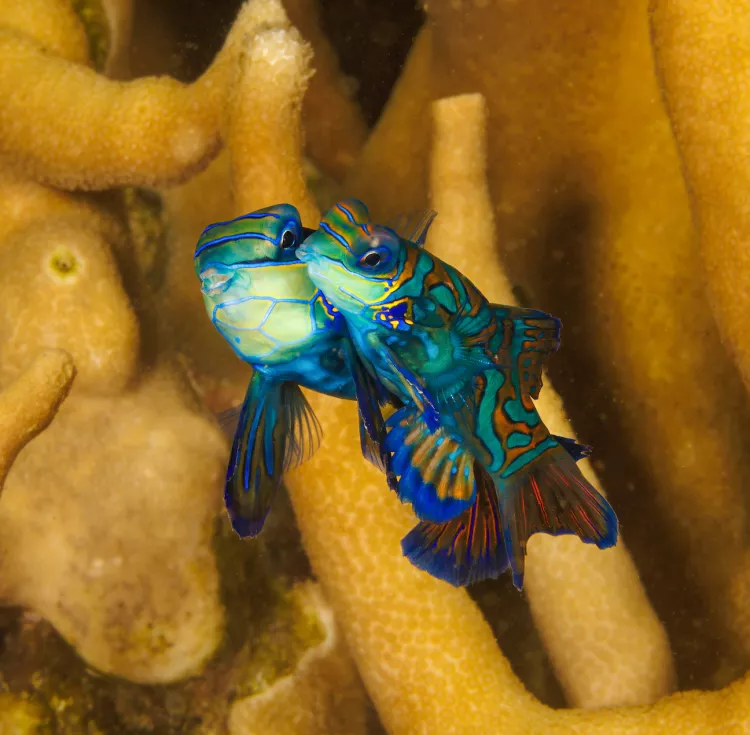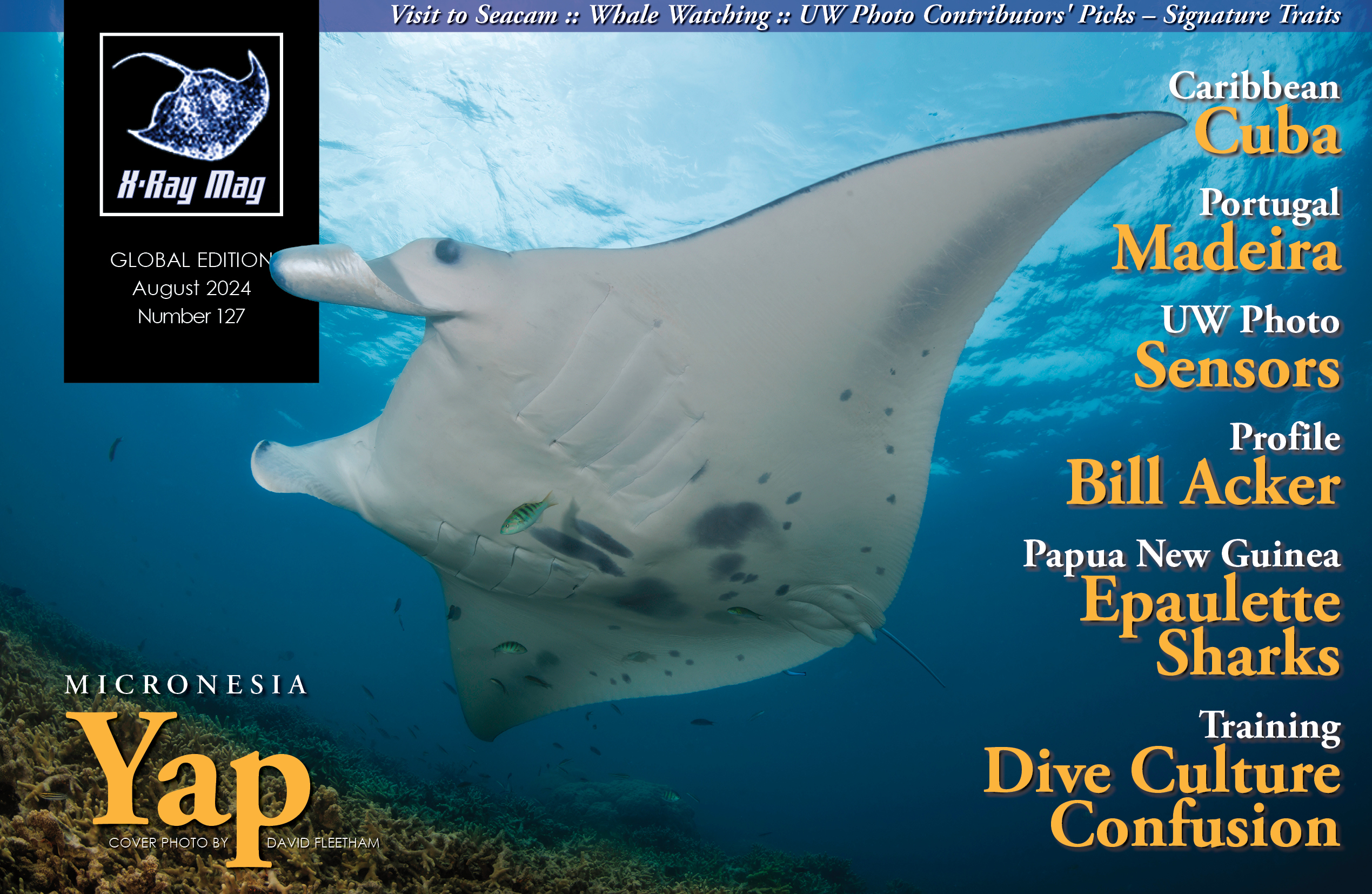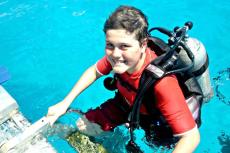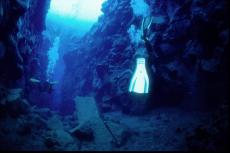In the western Pacific island group of Yap, divers can enjoy beautiful tropical reefs teeming with diverse marine life, including majestic manta rays, and experience the thrill of blackwater diving. Underwater photo pro David Fleetham tells us about his adventure there.
Contributed by
I have been to Yap many times. For more than a decade, I have been one of several professional photographers invited to MantaFest to share my camera experience with the full house of guests at Manta Ray Bay Resort. Each year, upon my departure, owner Bill Acker has invited me to come back any time to enjoy what Yap has to offer. I finally accepted and spent seven perfect days diving as a guest rather than a staff member. My girlfriend, Jennifer Ross, also joined me for the entire week.
The flight from Guam arrived at the ungodly hour of 1:10 a.m. Remarkably, the resort staff were wide awake and chipper at this hour, greeting us with a bottle of water and a chilled washcloth to wipe off the airline ambience. They handled all our luggage and tagged it with our room number. During the 15-minute ride to the resort, we were informed of all the things that we needed to know about the resort’s operations, the diving and the resort restaurant, The Mnuw. On our bus were a number of divers and a group of would-be ornithologists from the United Kingdom who were excited to view the four endemic species found on Yap—basically, the above-water version of divers looking for rare fish species.
Shortly after, we made it to our room, and so did our bags—five 50-pound cases of cameras and dive gear padded with our garments. We agreed to deal with the equipment in the morning—well, later that same morning—after getting some much-needed shut-eye. With blackout curtains drawn, the hum of the air conditioner and no alarm clock, morning soon turned to afternoon, and we leisurely assembled our cameras and carried our scuba equipment down to the dive shop.

Diving
Slow and Easy. We were assigned dive cubicles number 56 and 57 and a bag with the same number. This was where our dive gear would be stored at the end of the day after being rinsed by the staff. The day was getting away from us, so we decided to do an afternoon dive at Slow and Easy, a site close to the resort that we had visited many times before. It did not boast the amazing visibility of the other sites, but it had a wealth of macro critters if you took the time to look or if you were diving with one of the Yap dive guides who knew how to find even the tiniest of nudibranchs. We stayed fairly shallow and stretched our bottom time to 90 minutes. A good start to the week.
A 10-minute boat ride had us back at Yap Divers before we had even got out of our wetsuits. We dunked our cameras into the two dedicated camera rinse tanks, making sure to push all the buttons to flush out the salt water. While we were doing this, the crew put our dive gear in the equipment rinse tanks and then hung it up to dry in the locker area. It was just a matter of peeling out of our neoprene under the outdoor showers, grabbing fresh towels, hanging up our wetsuits to dry, and we were ready to pull our memories captured in pixels out of our cameras and plug everything in to charge.
The pool was situated along the walk back to our accommodation and we were tempted to jump in for another rinse, but with pixel images in our minds, we made a dash for the room to download our cards onto our PowerMacs and plug in external drives to back everything up. As we shared what we had shot, we made a pact to return to Slow and Easy for a night dive.
That evening, we tore ourselves away from our screens and wandered down through the lobby, past the dive shop and up the short walkway leading to The Mnuw, a 170ft phinisi schooner originally from Indonesia, which was the resort’s restaurant and bar. The dinner menu was written on a chalkboard and changed daily, along with the fresh fish caught that day. Jennifer and I ordered the sushi platter, fish tacos and mugs of Hammerhead Amber Ale from the resort’s own microbrewery, the Stone Money Brewing Company. Freddy, their Swiss brewmeister, produces two varieties in 600-litre batches just off the hotel lobby and has it down to a fine science. The kitchen was at the bottom of the ship, and a vintage-era dumbwaiter brought our dishes to us just as the sunset colours faded into the night sky.
After a quick glance at the whiteboard with the next day’s dive schedule, we headed for our pillows. An 8:00 a.m. departure and a three-dive day was on the books.

The Mi’l Channel
Breakfast at The Mnuw started at 6:30 a.m., and we got in shortly after the doors opened. A spread of local fruit, bacon, rice, scrambled eggs, toast and other baked goods was laid out, and we ordered custom omelettes from the chef in the corner. Coffee and tea greeted us as we sat down, and two plates were not far behind.
By 7:30, we were in the camera room, checking that all the batteries were charged, and the housings were well sealed. Our dive gear was already on the boat, and all we had to do was analyse our nitrox mixes and attach our regulators. Three other divers from California joined us, along with our captain and guide. Ten minutes after leaving the dock, we found ourselves zipping through a narrow channel in a mangrove forest on our way to the other side of the island and the Mi’l Channel.
We grabbed a mooring, and our guide, Bruce, explained that we had a flooding tide and would be riding the current into the channel to a ridge where a school of jacks liked to congregate. It was a drift dive, and the boat would pick us up wherever we ended the dive.
The incoming tide brought clear water, and we dropped to the bottom of the passage at 55ft and crossed to the other side. A manta ray greeted us, gliding against the current with seemingly no effort. As we got to the ridge, a second manta ray passed overhead, or perhaps the same manta ray turned around. We did not get a firm ID on the first one.
In front of me, Jennifer pointed out a large Javanese moray eel swaying in the current, and I motioned for her to turn around as the school of jacks surrounded us. They were very used to seeing divers and exceedingly cooperative subjects. We spent the rest of the dive photographing the school as it circled, then turned and headed back towards the ridge. After three minutes at 15ft, we surfaced, and Captain Brian brought the boat to pick us up.

Stammtisch. The next dive was a bit further into the Mi’l Channel at a site known as Stammtisch. The manta rays we saw on our first dive were likely on their way to this reef, where they like to get cleaned. The mooring is 100 yards from the cleaning station, which is as shallow as 8ft deep on a low tide. The idea was to have as little impact on the cleaning area as possible, so we did not mind making the short swim over to the area that Bruce had indicated would be our best vantage point without disturbing the action.
Visibility was not as good as on the first dive, which is typical as you get closer to the mangrove forests that are so prominent around Yap. The coral was a bit worn down from years of divers taking advantage of the same places. Fish that had been difficult to approach on other reefs immediately began swimming up to us—angelfish, wrasse, butterflyfish and parrotfish. So, not only was this a good spot for manta rays, but it was also a unique area for getting fish shots of species that are difficult to get close to on regular dives. It was not quite like “shooting fish in an aquarium,” but it was certainly close. Several of my manta ray shots were “photobombed” by these reef fish residents.
Within ten minutes, our first manta ray showed up, passing right over Jennifer’s head to circle around the cleaning station. Cleaner wrasse and other species of wrasse were joined by butterflyfish to inspect the manta rays for parasites, a spectacle of symbiotic dexterity. A few minutes later, a second manta came by, and the two danced a swirling marine waltz until one of them objected to an over-enthusiastic cleaner and darted vertically to touch the surface, only to roll completely over and return to the dance.
This went on for over an hour until Bruce signalled that he was guiding the rest of our group back to the boat. He indicated that we were fine where we were and that he would be back. The great thing about diving with Yap Divers is that they allow you to utilise your bottom time as you wish. There is rarely a time limit put on your dives, and when you are in just 15ft of water, that can be a long time. We made the most of it and returned to the boat around the two-hour mark. The prepared lunch had already been served to the others, and we joined them under the shade while Captain Brian switched our gear onto fresh tanks.

Sakura Terrace. We discussed our third dive and agreed that we would take advantage of the tide to make our way back through the mangrove channel to the resort side of the island for Sakura Terrace and better visibility, along with the chance of seeing a cuttlefish. From the mooring, we dropped to the reef at 30ft and then made our way down the coral slope. The visibility was the best of the day, which made the variety of hard coral formations all the more spectacular. A large carpet anemone covered a fresh patch of eggs laid by the two Clark’s anemonefish, which took turns fussing over their future offspring. They flicked any sediment off the bright orange orbs with their pectoral fins and then blew water over them through their mouths.
It was a drift dive, and Bruce signalled that he was moving on in search of cuttlefish. We decided to linger a bit longer with the colourful anemonefish parents and caught up with the group half an hour later, but alas, the cuttlefish was not making itself available today. We did see two whitetip reef sharks napping under a ledge, and a large nurse shark made its way against the current below us in deeper water than we were prepared to experience on our third dive of the day. We all surfaced together. Brian plucked us out of the clear water, and 15 minutes later, we were back at the resort.

Yap Caverns
Our third day was a two-tank dive in the morning and then a night/dusk dive to photograph mandarinfish. We headed out of the channel in front of the town of Colonia and turned right towards Bill Acker’s favourite dive site, Yap Caverns.
The surrounding reef extended out into open ocean from the southern end of the island to a point that dropped quickly into deep ocean. The vertical, current-swept wall began at 20ft, but at Yap Caverns, a section of the wall had long since collapsed, with huge sections tumbling down the slope. What remained was a series of canyons cut into the reef and several free-standing pinnacles on the outer edge.
Large schools of anthias hovered over the spires, feeding in the passing water. Hunted by jacks, they pulsed back into the reef and then cautiously took their chances back in the open ocean. Various species of anemones with anemonefish decorated this outer area, and grey reef sharks patrolled the blue. Below 100ft was a shark cleaning station, and the visibility was so good you could watch from above as they tried to hover and stay in place, opening their jaws while cleaner wrasse inspected between their teeth.
Bruce guided us back into the canyons, where a light was recommended. Eelgrass from beds close to the island blew out over the reef and accumulated in clumps on the sandy bottom. Our guide insisted there was something to see here, but it escaped me. Finally, a pipefish moved into a vertical position. It matched perfectly with the plant life it was using as camouflage. Nudibranchs, bright red soldierfish and eels occupied the corners back inside the canyon. As we emerged, a school of bumphead parrotfish was winding its way through the site. Too much for just one dive, we unanimously agreed to stay at Yap Caverns for our second dive.

Rainbow Reef
It was well into the afternoon when we got back to the resort, so we plugged in our batteries to recharge for our dusk/night dive in search of mandarinfish. It was still light when we got to Rainbow Reef, and Captain Nico explained that this was not your typical night dive. The mandarinfish would emerge from the finger coral at this time, and mated pairs could be seen regularly dancing up into midwater to release eggs and sperm just as it got dark.
Almost directly below the mooring, I saw my first subject and then another, and eventually, five of them moving about the convoluted maze of polyps. After several false starts, I got two of them together, but the climax ended in a split second. I was better prepared for the next pair and kept shooting continuously, hoping to capture the release of the eggs. Jennifer, just 40ft away, had her own harem and got to see the same spectacle.
Vertigo. The next morning found us zipping again through the mangrove passage to the other side of the island, but this time we passed through Mi’l Channel to the outside of the reef and a site called Vertigo. The Manta Ray Bay Resort has been feeding the sharks here for decades and has perfected the scenario for divers and photographers. Before we had even donned our gear, blacktip sharks were circling the boat.
We all descended to the bottom at 40ft, and a guide brought down a PVC pipe with bait and positioned it in the reef. It was explained that if you wanted to get close to the sharks, simply move closer to the container. If you wanted more of a distant perspective, just stay back. The sharks were well aware of their role and were well-behaved subjects. Once we were all back on board at the end of the dive, the bait was brought to the surface and tossed to a conglomeration of blacktip and grey reef sharks competing for their reward.
Stammtisch, again. Our second dive was back at Stammtisch for another stint with the manta rays. This time, I decided to go with a macro lens, shoot the overly cooperative reef fish, and ignore the giant winged regulars. Jennifer’s Olympus system allowed her to do both, and I was inwardly jealous. After two hours, the group had identified five different manta rays, with up to three at a time being serviced at the cleaning station. I had no complaints after capturing 30 different fish portraits that I would never have gotten on a single dive anywhere else.

Kayaking the mangroves
With just two dives left on our schedule, we headed back to The Mnuw for lunch and to prepare for our afternoon kayak tour through the mangrove forest. Our dive boat was filled with kayaks and paddles, and we departed the dock for a new adventure.
When we reached our destination, Bruce slipped the kayaks into the water, then we paddled under a local walkway and past a traditional men’s house with stone money decorating the sides. There was not a whisper of wind, and the paddling was easy. Birds flew overhead and chirped to each other as we left the wide channel and headed down a narrow opening in the forest, where it was silent. Here, the trees formed a canopy overhead, with sunlight filtering through the thick layer of green.
It was just two feet to the bottom, and our guide pointed out a large anemone on the muddy sediment with no anemonefish. It was the only one he had seen deep in the forest, and it appeared to be thriving somehow in the murky water.
Mangroves are vital for an array of fish species. Here, archerfish spit jets of water from their mouths into the air to knock insects into the water. It is also where many juvenile fish, including some species of sharks, begin their lives.
We emerged again into a wide channel and then took another turn into a narrow opening, not as wide as our paddles were long, and continued until we met up with our ride. We were surprised that the tour was over and even more amazed to learn that we had been paddling for over three hours.

Crescent Reef
Our fifth day began with a good breeze, and it was suggested that we stick a bit closer to the resort. Crescent Reef is just outside the entrance to the channel, and the wind had made little impact on the visibility. The mooring was anchored at 30ft at the edge of the reef, which dropped down to 60ft where it became a flat bottom that extended out to another drop-off. A school of barracuda patrolled over the sand, and large snappers hung motionless in the blue. Goby and shrimp shared a hole in the sand rubble areas, with the pair darting into their den as I approached. These pairs seemed to be everywhere. I slowed down and took my time to approach for a photo.
Circus Wreck. The wind had died down a bit, but we still preferred flat water and decided to dive the Circus Wreck inside the channel. Visibility here was not as good as on the outside of the channel, but the wreck made a dramatic backdrop to the reef beside it. The vessel came to Yap with a circus of animals, clowns and acrobats that had been traveling around Micronesia when it broke down and was abandoned. The circus company left the island on a barge, and the ship was sunk as a dive site. It was 75ft long and lay on its side in 70ft of water.
After making our way down the deck of the ship, we paused at the stern for a shot of the propeller, then worked our way up to a shallower depth and continued on down the reef. Several species of nudibranchs shared the corals with reef fish, including a very cooperative crocodilefish. It was a five-minute boat ride back to the resort, where we had lunch and rested for our blackwater night dive.

Blackwater diving
Blackwater diving can reveal creatures you will never see anywhere else. Yap is located on the rim of the Marianas Trench and just 100 miles from the Challenger Deep site, the deepest point on our planet. About a mile or so out in open ocean, a buoy is set with a light at the surface and several more lights at intervals down to 60ft to attract larval creatures that make a migration to the surface each night. A dive guide keeps the buoy and group together while spotting subjects. This is not a dive for novices, and it does take a few minutes to orient oneself to the whole situation.
Immediately upon descending, I came across a shrimp riding a jellyfish. The shrimp was propelling the jellyfish in a dizzying circle, and I took 30 shots, hoping one would catch the pair at the right angle. Hundreds of squid, from six inches to two feet long, darted past us in waves. Occasionally, one would pause momentarily to be photographed and then bolt back to the mob. I saw various larval fish, more jellyfish, including a box jellyfish, more shrimp and other crustaceans. It can be a sensory overload, and time goes by quickly. It was after 10 p.m. by the time we got back.

Return to Yap Caverns
Day 6 was our last day of diving, and we decided to go back to Yap Caverns. The current was running a bit stronger, so the grey reef sharks were a bit more plentiful, and everything that fed in the passing water was hard at work to get what they could. A huge school of rainbow runners passed through, and we heard dolphin squeaks, which were later confirmed when we surfaced.
Lionfish Wall. The wall was so alive that we decided to start a drift dive from where we were and travel down to the next site called Lionfish Wall. It was a challenge to stop for photos, but the sheer volume of marine life made up for shooting on the fly. Multiple colours of feather stars decorated the walls, along with wire coral, alcyonarian coral and fans deeper down. Even the safety stop at 15ft was filled with school after school of snapper, bream and surgeonfish.
Night dive
We had made a pact on the first day and kept it for our last dive. We ended up back at Slow and Easy for a wonderful night dive that started with a huge mantis shrimp whose hole was big enough to put your hand in. A hawksbill sea turtle, sleeping rabbitfish and parrotfish, lionfish, lobster, cowries, an upside-down jellyfish and a giant moray getting its dental work examined topped off our critter list for the last bubbles of this trip.

Topside attractions
Day 7 was for drying out our gear, packing and getting ready for our 2:35 a.m. departure the next morning. The hotel staff caught wind of a rehearsal for an upcoming cultural event and managed to get us on the guest list. This was to take place in the late afternoon, so we decided to join Derek, one of the staff, for a morning hike on the Tamilyog Trail, up a hillside to an ocean overlook and back down through the village where he lives.
It was a mild uphill climb on a well-tended path paved with stones that had been placed together like a jigsaw puzzle. The heat of the morning sun and the humidity added to the workout, but we were easily distracted by the jungle and grasslands around us. At the summit, we relaxed under a shaded rest hut, which had an ocean view of the reef surrounding the island. On the way down, we passed through Derek’s village, where he plucked starfruit and oranges from his trees to share.

The street in front of the village of Rumuu was bustling with traffic when we arrived in the early afternoon. Locals with food and drink were on the path and along the walkway over a stream leading to the dance area in the middle of the jungle. Fifty women in traditional dress were seated in a row along a stone path, and others were making last-minute adjustments to their dresses and make-up. It was an impressive and moving sight. The dancers spanned several generations, from toddlers to the elderly. As the only non-natives, we felt extremely privileged to be invited to the rehearsal, which went on for well over an hour and included seven or eight dances and chants.
The same cheerful staff who greeted us on our first night were at our door shortly after midnight to handle our bags and boxes for the drive to the airport. Our hugs and goodbyes were short and sweet as we reminded each other that we would be back in a few months for MantaFest 2024. ■






























